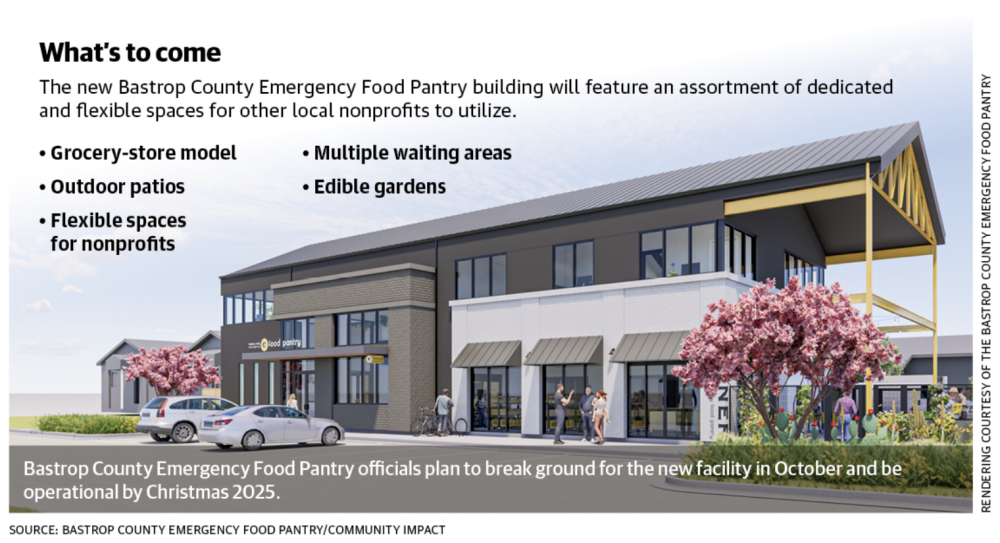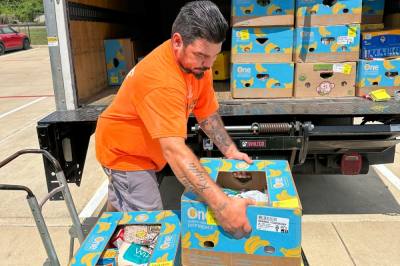The BCEFP team will break ground in the fall on a new facility to offset the increased need.
Manfredini said the growing demand is due to several factors, including reductions in Supplemental Nutrition Assistance Program, or SNAP, benefits along with the rising cost of housing and groceries.
“People are getting priced out of Austin, and after the [extra food benefits] went away ... we saw the huge increase,” Manfredini said. “If you’re choosing between not eating and going homeless, most people will choose the ‘not eating’ option. We use the phrase, ‘Rent eats first.’”
How we got here
In 2020, Congress passed the Families First Coronavirus Response Act, allowing states to provide SNAP households with the most assistance available; however, the temporary emergency allotments ended in 2023, as did summer food assistance for Texas children.
SNAP is a government food assistance program primarily for low-income individuals who receive a monthly stipend for food items. One of two sets of work requirements must be met to qualify, including those for able-bodied adults with and without dependents. Previously, the requirements had individuals ages 18-49 work or attend job training for at least 80 hours each month.
But The Fiscal Responsibility Act has gradually increased that age limit, meaning older individuals are required to work to qualify for food assistance. The age requirement will increase for a third time since September 2023 to 54 on Oct. 1.
Benefits are also determined depending on the household’s size and annual income level; for example, a two-person family making $26,572 per year would be eligible for SNAP.
This year, the United States Department of Agriculture began the Summer Electronic Benefit Transfer Program, which provided eligible families with $40 monthly for each eligible child to supplement the cost of food during the summer break. Texas was one of 15 states that did not implement the program in 2024, further increasing the need for food assistance from the BCEFP, Manfredini said.
The Bastrop pantry served 80% more people between 2020 and 2023, and those numbers continue to grow. In fact, Manfredini said she has previous volunteers who now rely on the pantry for assistance.
A closer look
The growth of food insecurity does not appear to be slowing down, said Tracy Ayrhart, spokesperson for the Central Texas Food Bank.
The Consumer Price Index, or CPI, shows the cost of staple foods such as bread, chicken, eggs and milk have continued to rise since 2019.
The CPI measures the change in prices paid by consumers for goods and services used for day-to-day living.
Grocery inflation has not only contributed to an increased demand for pantry assistance, but also a growing cost for the BCEFP to provide it. Manfredini said between 2020 and 2023, the cost of each meal climbed from $0.18 to $0.25, or 38.89%.
Why it matters
Manfredini said the BCEFP has to depend more on monetary and food donations from residents and businesses to keep up with the need.
“We’re having to purchase a lot more food because shipments from the Central Texas Food Bank are inconsistent,” Manfredini said. “We’ve already spent more so far this year than we spent for the entire year in 2020.”
CTFB said food shipments have remained consistent to BCEFP “despite some industrywide supply chain disruptions.”
Manfredini said because of the fluctuating deliveries, there have been times that the BCEFP’s shelves were nearly bare, and other times when it was full.
“Having almost half of our food source being inconsistent makes it difficult for us to fully serve our community,” Manfredini said. “So, we end up relying on community donations to fill the gaps from shipments.”
On Wednesdays, BCEFP officials post a callout on social media to request community assistance for an item the pantry needs most.
“We call it Wishlist Wednesdays,” Manfredini said. “We also have a list on our website of suggested items we need year-round.”
The plan
Manfredini said additional funding during COVID-19 allowed BCEFP officials to begin planning for a new facility, which will encompass 9,200 square feet at 1201 Pine St.
The current location, on Fayette Street, will be renovated into a nutrition and education center. Programs will include a computer lab, job readiness services, budgeting, cooking demonstrations, educational workshops, senior activities, and shared programming space with other nonprofits who can provide assistance.
“I can’t imagine not being [able] to feed my child every day,” said Jana Lynch, who hosts art events at 602 Brewing Company that benefit the BCEFP. “The implications of not being able to feed my family are horrific and heartbreaking. Raising awareness and money to help feed our community is the least I can do.”
In 2023, the pantry distributed 21% more pounds of food than in 2020, and Manfredini said they expect to see that trend continue. She said the current building is not large enough to meet demand, and the new facility will increase capacity for food storage from 50,000 pounds to 1 million pounds—a 1,900% increase.
The way food is distributed will change as well. Currently, recipients choose from a list of items and a box is filled for them by an official. The new system will be more like shopping in a grocery store, Manfredini said.
“The BCEFP is a valuable part of the services provided in our county,” said Bastrop Mayor Pro Tem John Kirkland. “We are happy to have them in our community and doing such great work.”

The cost
To pay for the new facility, BCEFP officials started the Capital Campaign in 2023 to raise •$7.5 million. To help, the Mabee and Anderson Foundations agreed to participate in challenge grants, where the BCEFP raises part of the goal, and the foundations match or exceed that same amount.
“We are almost there,” Manfredini said. “So far, we have raised 94% of our fundraising goal—which totals to about $7.05 million. We’re hoping to break ground on the facility in October, and it should be open by Christmas in 2025.”
Those who would like to help can do so through the BCEFP website, by mailing a check to P.O. Box 953 Bastrop, TX 78602, or by dropping it off at the center located at 806 Fayette St. in Bastrop.
Other ways to help include in-kind donations and legacy gifts.






